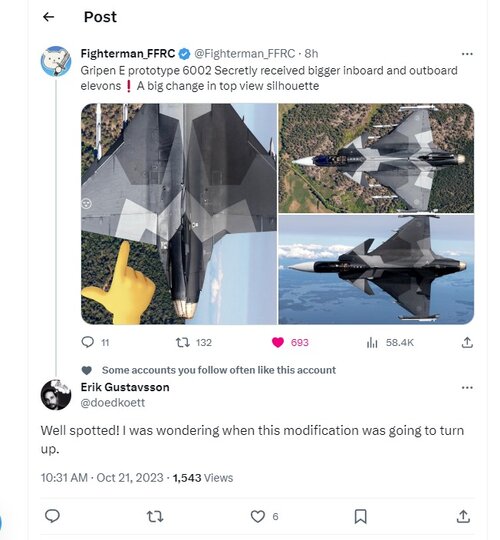A question in passing: why did SAAB made the Gripen so small, compared to the Viggen ? Did the later proved really expensive in service ? (also never quite understood why all Viggens were brutally withdrawn from service in 2006).
I can't think of many countries going that way: from a larger type to a much smaller one. Although the recent history of combat aircraft has not that many big players, so lot of biases everywhere.
Strange because the answer is pretty obvious: Gripen has the
lowest RCS above the F-35/F22 class.
Gripen while still excellent is getting old,
It's certainly not true for the E - its software platform is ahead of everyone else, and MADL is still catching up in networked warfare. No question US designs will catch up, but American military contractors are not known for their "nimble, quick-to-adjust" operations, rather for the opposite, so I don't expect them to do so before the second half of this decade (witness Boeing's successful courting of Saab for their advanced software expertise, and their subsequent win with T-7A.)
and most importantly, whatever the F-35 cost and flaws, that 3000-airframe thing is turning into a huge steamroller.
For Lockheed, you mean - for sure.

For the users it's a bottomless financial pit, almost everywhere. No wonder most smaller users were forced to reduced their order numbers, then even those planes fly a lot less now (which LM gleefully exploits by selling them "simulators which replace actual flying", an atrociously obvious BS.)
What we need to watch is the Finnish deliveries - how LM's promised numbers will "evolve" over time... it's an art form here in America to convince the client that they actually
want to ignore the contractual amount and spend more on other blings.

I would not be surprised Gripen becomes an early casualty. Against F-35 it has two defects a) a little small and b) not stealth.
Err, which are actually advantages, along with the results: fraction of its lifecycle cost, flying cost, training and infrastructure costs. Did I mention it carries the Meteor, IRIS-T, and has a more modern software platform?
(The latter is at the core of that hopelessly screwed up mess a.k.a. F-35 Program - Lockheed truly and royally f'd it up. I am convinced that our military sw development standards is a really nasty, archaic pile of guano, and they should really fix it before they try to reinvent things that already work better in the civil world.)
Rafale is still resisting the steamroller but for how long ?
That has been the F-35 plan since 2001 and after 20 years it is happening...
Err, you are confusing the naked brute force political pressure with superior business & technical offerings - basically every major F-35 win was tainted by US political pressure. Meanwhile here, at home, that "steamroller" lost
hundreds of orders because the USAF and the Army hates Lockheed for this insanely overpriced, far too problematic, high-maintenance mess...
Light fighters were very 80s, they were all the rage but few sold well, Hawk 200 and AMX at the subsonic end proved very niche, the supersonic Gripen still very niche and could never compete with the F-16 support package and equipment/engine/weapons options it provides.
Say what...?

Even Block 70 isn't even a competitor against a Gripen E - it lacks Meteor or IRIS-T, completely lacks a modern networked warfare suit, yet costs more to maintain and even fly. Saab's support is top notch, according to every Gripen user, it easily outmatches anything LM can offer; in fact, leased planes
are actually Flygvapnet fighters, under their maintenance regimen, not to mention unlike LM
they offer local participation in the supplier and maintenance chain, depending on the agreement.










![JAS-39E_05 [top view].jpg](/data/attachments/245/245752-9c9740cd3836323596a87a05af0784e8.jpg)
![JAS-39E_49 [TE mod].jpg](/data/attachments/245/245753-cd34ac19c4d13d6ef56e5b4ef733b4fa.jpg)
![JAS-39E_[canards before].jpg](/data/attachments/245/245779-d412dd3e69963cdd7a5396b24e0a803f.jpg)
![JAS-39E_ [canards mod].jpg](/data/attachments/245/245780-310d1813afead8767fdce2dd6b845b4e.jpg)
